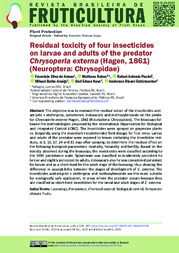Residual toxicity of four insecticides on larvae and adults of the predator Chrysoperla externa (Hagen, 1861) (Neuroptera: Chrysopidae).
Residual toxicity of four insecticides on larvae and adults of the predator Chrysoperla externa (Hagen, 1861) (Neuroptera: Chrysopidae).
Author(s): ARMAS, F. DE; RAKES, M.; PASINI, R. A.; ARAÚJO, M.; NAVA, D. E.; GRUTZMACHER, A. D.
Summary: The objective was to evaluate the residual action of the insecticides acetamiprid + etofenprox, spinetoram, indoxacarb and methoxyfenozide on the predator Chrysoperla externa Hagen, 1861 (Neuroptera: Chrysopidae). The bioassays followed the methodologies proposed by the International Organization for Biological and Integrated Control (IOBC). The insecticides were sprayed on grapevine plants cv. Burgundy, using the maximum recommended field dosage for fruit trees. Larvae and adults of the predator were exposed to leaves containing the insecticide residues, at 3, 10, 17, 24 and 31 days after spraying, to determine the residual effect on the following biological parameters: mortality, fecundity and fertility. Based on the toxicity observed during the bioassays, the insecticides were classified according to the IOBC persistence scale. Spinetoram was classified as moderately persistent to larvae and slightly persistent to adults, indoxacarb also he was considered persistent for larvae and as a short-lived for the adult stage of the lacewing, thus showing the difference in susceptibility between the stages of development of C. externa. The insecticides acetamiprid + etofenprox and methoxyfenozide are the most suitable for ecologically safe application, in areas where the predator occurs because they are classified as short-lived insecticides for the larval and adult stages of C. externa.
Publication year: 2023
Types of publication: Journal article
Observation
Some of Embrapa's publications are published as ePub files. To read them, use or download one of the following free software options to your computer or mobile device. Android: Google Play Books; IOS: iBooks; Windows and Linux: Calibre.
Access other publications
Access the Agricultural Research Database (BDPA) to consult Embrapa's full library collection and records.
Visit Embrapa Bookstore to purchase books and other publications sold by Embrapa.

